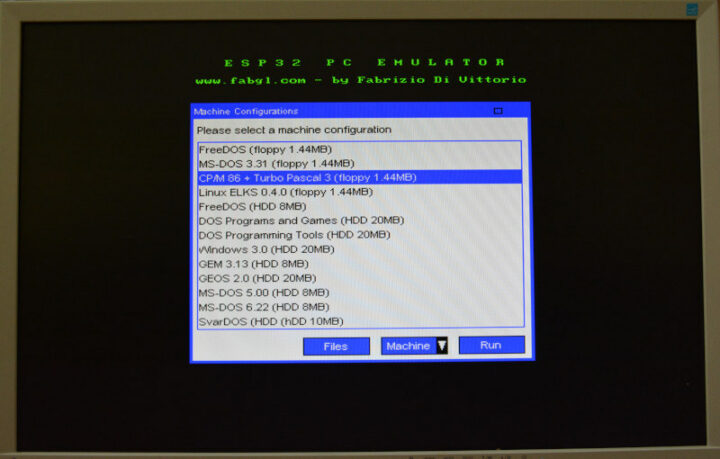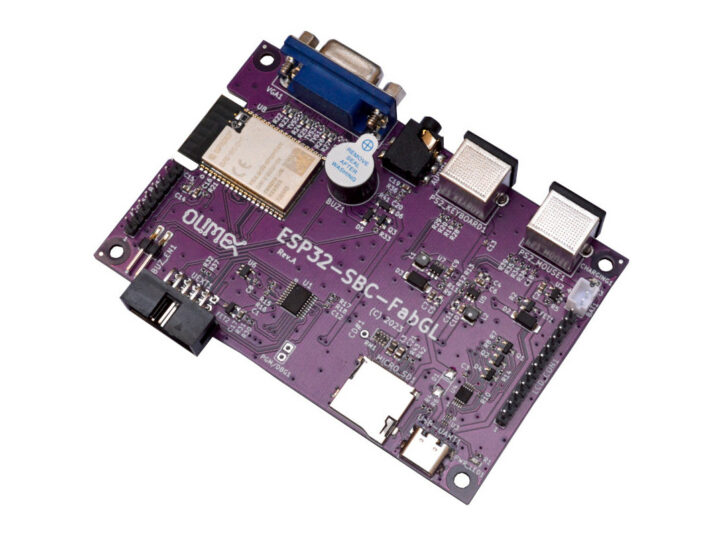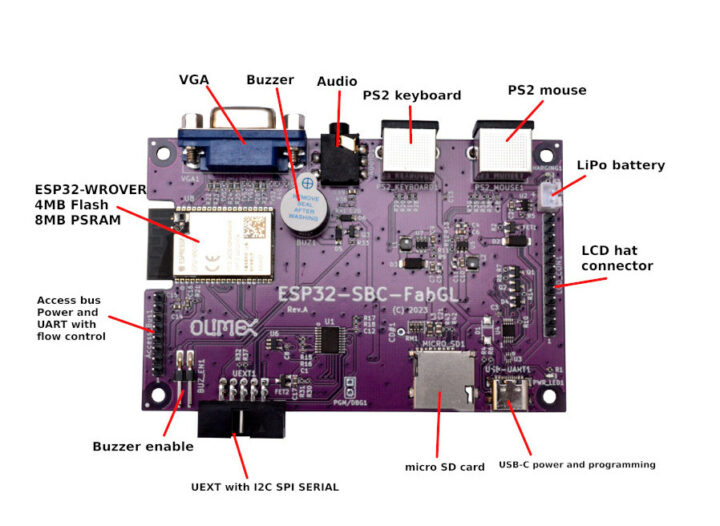Olimex ESP32-SBC-FabGL is an ESP32 single board computer that can serve as the brain of a retro computer with a VGA port, a 3.5mm audio jack, and two PS/2 ports for a keyboard and mouse that are handled by the open-source FabGL graphics library.
The board also comes with a microSD card slot, a buzzer, and various expansion interfaces, and can be powered via its USB port or a LiPo battery. FabGL implements several emulators including an Intel 8080 CPU emulator that allows the system to run various versions of DOS among other things.
ESP32-SBC-FabGL specifications:
- Wireless module – ESP32-WROVER dual-core WiFi and Bluetooth module with 4MB flash, 8MB PSRAM
- Storage – MicroSD card slot
- Display – VGA connector, 12-pin LCD HAT connector to enable handheld designs
- Audio – 3.5mm audio jack, built-in buzzer
- USB – 1x USB-C port for power and programming
- User inputs – PS2 keyboard connector, PS2 mouse connector
- Expansion
- UEXT connector with I2C, SPI, and serial interfaces
- 8-pin “access bus” with power and UART with flow control for graphics, sound, keyboard, and mouse add-on boards.
- Power Supply
- 5V via USB Type-C port
- LiPo battery connector
- Dimensions – 105 x 65 mm
As mentioned above FabGL provides device drivers for all the interfaces and supports emulators for a range of targets, or more exactly four at this time, namely Zilog Z80, Intel 8080, and MOS 6502 processors as well as the VIA 6522. Olimex came out with the ESP32 idea after working on the Agonlight2 board that used an ESP32 as a graphics, sound, and IO keyboard co-processor for the board’s Zilog eZ80F92 8-bit microcontroller.

Olimex has already assembled several prototypes and tested Altair8080 with CP/M, IBM-PC with DOS as shown above, and Turbo Pascal 3.0. The company says it will start taking pre-orders soon for 15 Euros with the board becoming available in June. The price for the board includes royalties to Fabrizio Di Vittorio, the author of FabGL, so it will also help with furthering the development of the software project. [Update July 2023: The ESP32-SBC-FabGL is now be ordered on Olimex shop]

Jean-Luc started CNX Software in 2010 as a part-time endeavor, before quitting his job as a software engineering manager, and starting to write daily news, and reviews full time later in 2011.
Support CNX Software! Donate via cryptocurrencies, become a Patron on Patreon, or purchase goods on Amazon or Aliexpress







Glad to hear good old Olimex is still alive and kicking !
Can support up to 64 gb?
So it also emulates a 8086, because the 8080 is only for CPM/80 and co. But that’s great then! I already have a CPM + various programs on an ESP8266 somewhere using a comparable emulator. I really like this approach, because older machines are easy to emulate and the emulated code runs fast comparatively to the real machines in question, at much lower power.
And it’s only 15 EUR! I’ve long wanted to make something like this, I’ll definitely order one!
It looks like a revival of 3-4 year old project.
Upgrade from previous hardware are:
– LCD display
– Buzzer
– USB-C
Are there any software improvement that were made in the last 1-2 years?
Based on the announcement linked at the end of this article, Olimex appears to have only recently learned about FabGL after they worked on the Argonlight2 board. So FabGL was not used 3 to 4 years ago.
Agreed. There is not much leap from tiny VGA32 and most of ‘features’ mentioned are just from pcemulator demo in FABgl project.
If I am interpreting their post correctly, the “access bus” (port) is actually meant for processor cards.
That is, there could be external processor cards which could use the ESP32-SBC-FabGL board as their co-processor for graphics, sound, keyboard, mouse.
I guess the board could easily work stand-alone too though.
“Intel 8080 CPU emulator that allows the system to run various versions of DOS among other things.”: Retro afficionados should know that early PCs used intel 8088 (a 16-bit processor), not intel 8080 (an 8-bit one with a completely different architecture). The main OS used in 8080 and Z80 PCs was CP/M. DOS (either IBM PC-DOS or MS-DOS) required 8088 ones (the predecessors of modern x86 CPUs.
how can i order it ? no way ?
I’ve updated the end of the post with the purchase link.